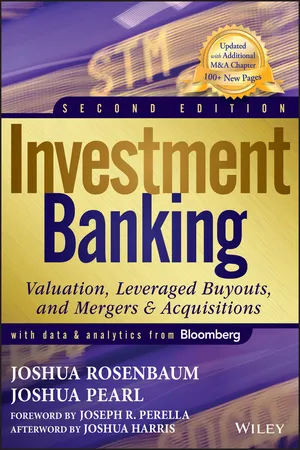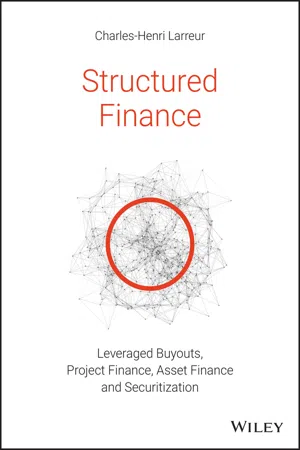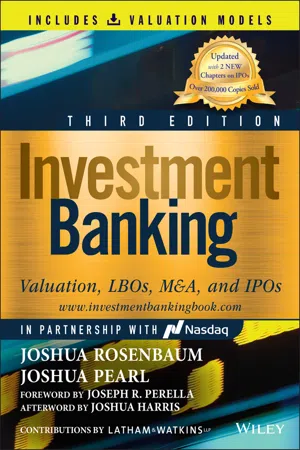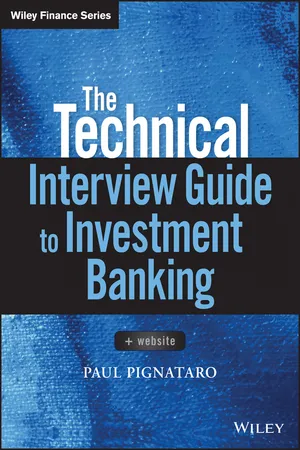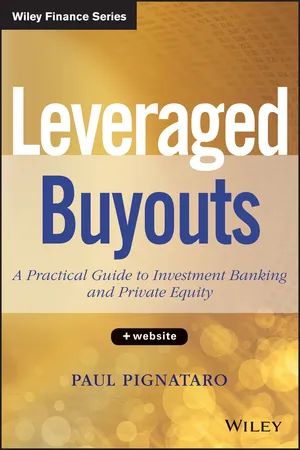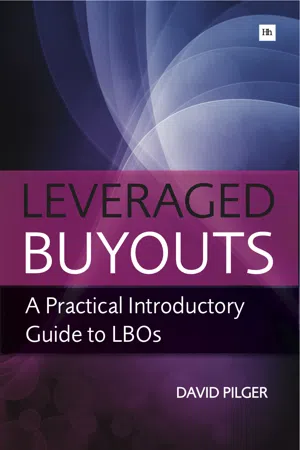Business
Leveraged Buyout
A leveraged buyout (LBO) is a financial strategy where a company is acquired using a significant amount of borrowed money, typically through loans or bonds. The assets of the company being acquired are often used as collateral for the borrowed funds. LBOs are often used to take a public company private or to restructure a company's ownership.
Written by Perlego with AI-assistance
Related key terms
10 Key excerpts on "Leveraged Buyout"
- No longer available |Learn more
Investment Banking
Valuation, Leveraged Buyouts, and Mergers and Acquisitions
- Joshua Rosenbaum, Joshua Pearl(Authors)
- 2013(Publication Date)
- Wiley(Publisher)
PART Two Leveraged BuyoutsPassage contains an image
CHAPTER 4 Leveraged Buyouts
A Leveraged Buyout (LBO) is the acquisition of a company, division, business, or collection of assets (“target”) using debt to finance a large portion of the purchase price. The remaining portion of the purchase price is funded with an equity contribution by a financial sponsor (“sponsor”). LBOs are used by sponsors to acquire control of a broad range of businesses, including both public and private companies, as well as their divisions and subsidiaries. The sponsor's ultimate goal is to realize an acceptable return on its equity investment upon exit, typically through a sale or IPO of the target. Sponsors have historically sought a 20%+ annualized return and an investment exit within five years.In a traditional LBO, debt has typically comprised 60% to 70% of the financing structure with equity comprising the remaining 30% to 40% (see Exhibit 4.12 ). The disproportionately high level of debt incurred by the target is supported by its projected free cash flow1 and asset base, which enables the sponsor to contribute a small equity investment relative to the purchase price. The ability to leverage the relatively small equity investment is important for sponsors to achieve acceptable returns. The use of leverage provides the additional benefit of tax savings realized due to the tax deductibility of interest expense.Companies with stable and predictable cash flow, as well as substantial assets, generally represent attractive LBO candidates due to their ability to support larger quantities of debt. Free cash flow is needed to service periodic interest payments and reduce the principal amount of debt over the life of the investment. In addition, a large tangible asset base increases the amount of bank debt - eBook - ePub
Private Capital Investing
The Handbook of Private Debt and Private Equity
- Roberto Ippolito(Author)
- 2019(Publication Date)
- Wiley(Publisher)
CHAPTER 9 Leveraged BuyoutINTRODUCTION
A Leveraged Buyout (LBO) is the acquisition of a whole company or a division thereof (the ‘Target’) financed with an above average level of debt (usually secured). Debt is provided by one or more ‘acquisition finance’ houses (usually banks), is repaid by the Target's cash flow (and sometimes also upon the sale of selected Target's assets), and is secured against the Target's assets. Equity is provided by a private equity fund (the ‘Sponsor’), which takes a relatively small equity investment risk; the Sponsor's objective is to realise an adequate return on its equity investment upon exit (typically through a sale or IPO of the Target). Management usually retains a shareholding that is often incentivised.There are various types of buyout:- management/Leveraged Buyout, also referred to as (M)LBO: managers acquire a business they have been managing and voting control after the buyout lies with the management team;
- management buy-in (MBI): the management does not already work for the target company, but is taken on by the Sponsor, and will co-invest alongside;
- leveraged build up/platform buyout/roll on: buyout with the intention of making further synergistic acquisitions;
- sponsored spin out: a new company is owned by the previous owners;
- leveraged recap(italisation): a company borrows money in order to make a cash payout to existing shareholders.
In general narrative terms the elements of a typical LBO can be summarised as follows: the first stage involves raising the necessary funds (debt and equity) and establishing a management incentive system. Normally the investor group (led by the Sponsor and the company's top management) provides 30–50% of the price paid (also called the ‘Transaction Value’), while the remainder is provided by the lenders (banks, specialised debt providers, and/or capital market). At the second stage, the Sponsor purchases all (or the vast majority) of the outstanding shares of the Target or the assets of the company. At the third stage, the management implements operating efficiencies (cost cutting, asset optimisation) and executes eventual growth strategies (mainly via acquisitions) so as to increase profits and cash flow. In the last stage (after the majority or whole acquisition/LBO debt has been repaid), the Sponsor sells the Target. Financial sponsors generally seek to exit in three to five years. There must be a clear route to exit, to be established before the close of the deal: potential exit routes include IPO, trade sale, leveraged recapitalisation, and break-up. - eBook - ePub
Structured Finance
Leveraged Buyouts, Project Finance, Asset Finance and Securitization
- Charles-Henri Larreur(Author)
- 2021(Publication Date)
- Wiley(Publisher)
PART I Leveraged Buyout (LBO)An LBO or Leveraged Buyout refers to the acquisition of a company with a combination of equity and debt. It is a financial technique that slowly emerged at the beginning of the twentieth century. LBOs, however, have only really taken off since the early 1980s, around the same time as project finance, asset finance, and securitization.Readers with a background in finance are generally more familiar with LBOs than with the other financing techniques analyzed in this book. LBOs are a topic that might have been encountered in previous reading or studied in a course related to business valuation or corporate finance.Without ignoring the link between corporate finance and LBOs, we think of the LBO as primarily a financing technique. Debt is indeed used to finance the acquisition – via an SPV – of an asset that generates cash flow. LBOs are in this respect similar to the other structures that we will discuss in this book. The main difference is the nature of the asset that is financed. It is a company in the case of an LBO, rather than an infrastructure asset, as in project finance (Part II ), a moveable asset, as in asset finance (Part III ) or a portfolio of receivables, as in securitization (Part IV ).LBOs combine all the elements of structured transactions: (i) use of an SPV; (ii) recourse to financial leverage; and (iii) tax optimization. They tend to get more media attention than other structured finance techniques, probably due to the fact that some companies taken over via LBOs are extremely well known. It is easier to make headlines in the Financial Times with the acquisition of Burger King or Harley‐Davidson than with the financing of a wind farm in Illinois or Colorado.LBOs exemplify probably more than any other technique the series of financial revolutions addressed in this book. It is, therefore, only natural to start our journey with a plunge in the intricacies of Leveraged Buyouts. We hope that readers who are not familiar with the concept will discover its mysteries. For others, we hope that they will rediscover the spark – and the fun! – of this technique. - eBook - ePub
Investment Banking
Valuation, LBOs, M&A, and IPOs (Book + Valuation Models)
- Joshua Rosenbaum, Joshua Pearl(Authors)
- 2022(Publication Date)
- Wiley(Publisher)
PART Two Leveraged BuyoutsPassage contains an image
CHAPTER 4 Leveraged BuyoutsA Leveraged Buyout (LBO) is the acquisition of a company, division, business, or collection of assets (“target”) using debt to finance a large portion of the purchase price. The remaining portion of the purchase price is typically funded with an equity contribution by a financial sponsor (“sponsor”) or equivalent. LBOs are used by sponsors to acquire control of a broad range of businesses, including both public and private companies, as well as their divisions and subsidiaries. The sponsor’s ultimate goal is to realize an acceptable return on its equity investment upon exit, typically through a sale or IPO of the target. Sponsors tend to seek a 15% to 20% annualized return and an investment exit within five years. PE funds range in size from tens of millions to tens of billions of dollars, and some sponsors manage numerous funds.In a traditional LBO, debt typically comprises 60% to 70% of the financing structure with equity comprising the remaining 30% to 40% (see Exhibit 4.12 ). The relatively high level of debt incurred by the target is supported by its projected free cash flow1 and asset base, which enables the sponsor to contribute a small equity investment relative to the purchase price. The ability to leverage the relatively small equity investment is important for sponsors to drive acceptable returns. The use of leverage provides the additional benefit of tax savings realized due to the tax deductibility of interest expense.Companies with stable and predictable cash flow, as well as substantial assets, generally represent attractive LBO candidates due to their ability to support larger quantities of debt. Free cash flow is needed to service periodic interest payments and reduce the principal amount of debt over the life of the investment. In addition, a large tangible asset base increases the amount ofsecured debt - Paul Pignataro(Author)
- 2017(Publication Date)
- Wiley(Publisher)
Part Five Leveraged BuyoutsA Leveraged Buyout is an acquisition of an entity using a significant amount of debt to meet the acquisition cost. Leveraged Buyouts are typically conducted by private equity funds designed to acquire businesses with the hope that they can exit the business at a later date, making a return on the investment. An understanding of this topic is necessary for those interested in the private equity industry. The technical Leveraged Buyout modeling is often seen as complex, and so knowledge of Leveraged Buyouts would set one apart competitively even in an investment banking interview process. In addition, there are some investment banking groups that do Leveraged Buyout modeling. If you find an interest or need to review Leveraged Buyouts in more complete detail, read my book, Leveraged Buyouts.Passage contains an image
CHAPTER 8 Leveraged Buyouts Overview
A Leveraged Buyout is an acquisition of a company using a significant amount of debt to meet the cost of the acquisition. This allows for the acquisition of a business with less equity (out-of-pocket) capital. Think of a mortgage on a house. If you take out a mortgage to fund the purchase of a house, you can buy a larger house with less out-of-pocket cash (your down payment). Over time, your income will be used to make the required principal (and interest) mortgage payments; as you pay down those principal payments, and as the debt balance reduces, your equity in the house increases. Effectively, the debt is being converted to equity. And maybe you can sell the house for a profit and receive a return. This concept, on the surface, is similar to a Leveraged Buyout (LBO). Although we use a significant amount of borrowed money to buy a business in an LBO, the cash flows produced by the business will hopefully, over time, pay down the debt. Debt will convert to equity, and we can hope to sell the business for a profit.- eBook - ePub
Leveraged Buyouts
A Practical Guide to Investment Banking and Private Equity
- Paul Pignataro(Author)
- 2013(Publication Date)
- Wiley(Publisher)
PART One Leveraged Buyout Overview A Leveraged Buyout (LBO) is a fundamental, yet complex acquisition commonly used in the investment banking and private equity industries. We will take a look at the basic concepts, benefits, and drawbacks of a Leveraged Buyout. We will understand how to effectively analyze an LBO. We will further analyze the fundamental impact of such a transaction and calculate the expected return to an investor. Last, we will spend time interpreting the variables and financing structures to understand how to maximize investor rate of return (IRR). The three goals of this part are: 1. Understanding Leveraged Buyouts (Leveraged Buyout theory). Concepts. Purposes and uses. 2. Valuation overview (What is value?) Book value, market value, equity value, and enterprise value. Understanding multiples. Three core methods of valuation: i. Comparable company analysis. ii. Precedent transactions analysis. iii. Discounted cash flow analysis. 3. Ability to understand a simple IRR analysis (Leveraged Buyout analysis). a. Purchase price. b. Sources and uses. c. Calculating investor rate of return (IRR). CHAPTER 1 Leveraged Buyout Theory A Leveraged Buyout is an acquisition of a company using a significant amount of debt to meet the cost of the acquisition. This allows for the acquisition of a business with less equity (out-of-pocket) capital. Think of a mortgage on a house. If you take out a mortgage to fund the purchase of a house, you can buy a larger house with less out-of-pocket cash (your down payment). Over time, your income will be used to make the required principal (and interest) mortgage payments; as you pay down those principal payments, and as the debt balance reduces, your equity in the house increases. Effectively, the debt is being converted to equity. And maybe you can sell the house for a profit and receive a return. This concept, on the surface, is similar to a leverage buyout - eBook - ePub
Leveraged Buyouts
A Practical Introductory Guide to LBOs
- David Pilger(Author)
- 2012(Publication Date)
- Harriman House(Publisher)
Part I: Leveraged Buyouts Explained
Passage contains an image
Chapter 1: What Is An LBO?
If you’re looking for a job or about to start a new job in investment banking or corporate finance you’re probably going to have to know a thing or two about companies buying other companies. You may have picked up this book because you are just curious to know more about the workings of corporate finance and financial transactions. Well, you have come to the right place. But before we get started and dive into the makings of an LBO transaction, we first need to define what exactly an LBO is.An LBO or Leveraged Buyout is, simply put, one company buying another company and using a large amount of debt to do it. That’s it. So ‘why all the fuss?’ you might ask. Why does this type of transaction get set aside from other types of mergers and acquisitions? The answer lies in the inherent risks that go along with a transaction that is financed primarily with borrowed money.“An LBO is, simply put, one company buying another company and using a large amount of debt to do it.”There are a few things that we need to recognize about the debt that is used in a Leveraged Buyout transaction. The first is that the debt used to acquire the target company is often secured by the assets of the target. In other words, a potential buyer does not necessarily need to possess the financial means to purchase a target company. Instead, the target company just needs to have enough available collateral, in the form of its assets, to allow an outside buyer to obtain debt financing (secured by the target’s assets) to pay for the cost of the transaction. Debt financing can also be secured by the assets of the buyer, but naturally using someone else’s assets as collateral is always considered more attractive than pledging one’s own assets as security for debt financing.The second point to mention about the debt is that it can come in the form of bonds or bank loans. In the case of bonds, this means that the debt is issued and typically sold to investors in the capital markets. There is a fixed coupon rate that the target company must pay to its creditors (i.e. the purchasers of the bonds), which is dictated under the terms of the bond at issuance. The high levels of debt associated with Leveraged Buyouts, relative to the amount of equity in the target company, often results in the bonds being rated as junk or below investment grade. As credit ratings are used to gauge the risk of default, it should come as no surprise that loading up a company with debt will naturally increase the risk of default – and the higher the risk, the higher the interest rate the market is going to demand for lending. - eBook - ePub
Mergers & Acquisitions
A Practitioner's Guide to Successful Deals
- Harvey A Poniachek(Author)
- 2019(Publication Date)
- WSPC(Publisher)
•An LBO is the acquisition by an investor of a company with mostly borrowed money. The Debt for the acquisition is scheduled to be repaid by the operating cash flows of the company and/or proceeds from selling the company or refinancing the acquisition debt with new debt. The investor is not personally responsible for paying the debt nor is he required to add any other capital to support his or her investment.•LBOs have been around for 100 years but became more organized in the late 1980s with the creation of the syndicated loan market and the organization by the financial sponsors of mega private equity funds to be used for LBOs.•There are three types of LBOs: Public to Private Transactions, Private to Private Transactions and Management Buyouts.•LBOs typically reduce a company’s tax payments (and hence increase the returns available to its equity investors), primarily due to the tax shield from interest expense, and also on occasion due to the tax shield from increased depreciation and amortization expense following the write-up of a company’s assets upon its LBO.•Over the years, some LBO tax benefits and strategies have however been eliminated.•The debt financing of an LBO is provided by the traditional commercial banks, by Collateralized Loan Obligation funds, insurance companies, hedge funds and other types of funds, and in the case of public High-Yield Bonds, by more varied public investors.•There are many types of debt facilities used in the financing of an LBO including Bank Debt, High-Yield Debt and Mezzanine Notes. •A good LBO needs to have strong cash flows, good growth prospects, low capital expenditures, a strong asset base, and strong management.•The concept of leverage enhances the equity returns because of the low cost of debt. The equity return can be enhanced by Enterprise Value growth, debt repayment, and by acquisition multiple expansion.•In structuring an LBO, the first measurement is debt capacity. Basically, what is the maximum level of debt that a company can support. - eBook - ePub
The Decision to Delist from the Stock Market
Theory and Empirical Evidence of Going Private
- Barbara Fidanza, Ottorino Morresi, Alberto Pezzi(Authors)
- 2018(Publication Date)
- Palgrave Macmillan(Publisher)
2010 ) document that virtually all PE funds are set up as private limited partnerships with a ten-year term in which outside investors (e.g., banks, pension funds, insurance companies, etc.) act as passive limited partners and the PE firm is the controlling general partner. Limited partners have limited or no withdrawal rights prior to the expiration of the ten-year term. They are also potentially subject to additional capital calls by the PE general partner. Most PE firms use similar financing techniques in acquiring portfolio companies. The typical LBO is structured as a purchase of all of the publicly held stocks of a corporation by a privately held acquisition vehicle. A PE buyout firm generally controls this entity, with other types of buyers being much less common. The PE firm sponsoring the transaction will obtain its capital from the equity contributions of its buyout fund which, in turn, raises its capital from outside investors, and of the managers of the target firm plus the cash proceeds from privately placed loans secured by target firm assets and expected cash flows. As part of the acquisition, managers of the target firm obtain a significant equity interest in the firm. Normally, top managers in private-equity-owned firms have equity interests that are ten to twenty times larger than those held by their public company counterparts. After the acquisition, the general partners in the PE fund are actively involved in the strategic direction of the portfolio company. - eBook - ePub
- Eli Talmor, Florin Vasvari(Authors)
- 2011(Publication Date)
- Wiley(Publisher)
Mezzanine debt is a highly negotiated instrument between PE firms and their debt providers. It is typically tailored to meet the financing needs of the specific LBO transaction and needs to meet a certain return level for its investors. As such, it allows for great flexibility in structuring terms. Mezzanine debt typically has embedded warrants attached to it and provides between 0% and 10% of the total funding needed. This incremental capital comes at a cost below that of equity, with the purpose of enabling PE firms to stretch the leverage level and pay a higher purchase price when alternative capital sources are inaccessible.The equity capital in an LBO comprises 20% to 60% of the total capital. This figure varies over time and is highly dependable on conditions in the debt market and the preferred level of financial risk. This equity contribution provides a cushion to lenders and bondholders in the event that the financial condition of the LBO target deteriorates. The management often invests in equity with the PE firm. For very large LBOs several PE firms may team up to create a consortium of buyers, thereby reducing the amount of each individual PE fund’s equity contribution (these are known as club deals).Exhibit 12.5 shows a breakdown of the debt elements of an LBO transaction into four categories: senior, revolver, subordinated, and mezzanine debt. There may also be an existing debt element, but this is usually repaid as part of the transaction. Exhibit 12.5 shows a summary of these main debt elements with their characteristics. The financing structure is initially determined using estimates based on the breakdown in Exhibit 12.4 , the determination of debt capacity rules employed by the banks, and the lenders’ requirements regarding covenants and debt service ratios. The structure is then optimized using the LBO model as described in Chapter 13 on LBO modeling.Legal structureEXHIBIT 12.5 COMPARISON OF CHARACTERISTICS OF DEBT INSTRUMENTSA certain legal structure that facilitates LBO transactions has developed over time. As can be seen in Exhibit 12.6
Index pages curate the most relevant extracts from our library of academic textbooks. They’ve been created using an in-house natural language model (NLM), each adding context and meaning to key research topics.
